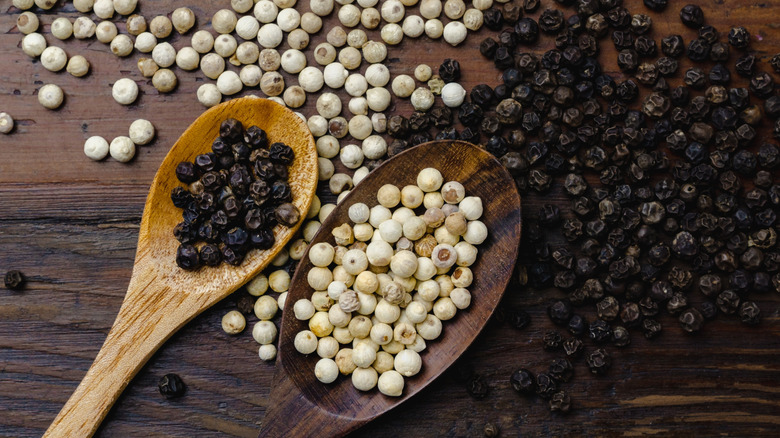Rachael Ray's Tip For Knowing When To Use Black Vs. White Pepper
After salt, pepper is typically the most common seasoning in most American kitchens — and most home cooks tend to stick to black pepper. But Rachael Ray wants you to know that it's also worth investing in white pepper to spice up your meals. In a segment on the "Rachael Ray Show," she spelled out what to know about this variety of pepper. "It's a different bang for your buck than black pepper," she said. "It's a mellow slow burn versus a pop kind of a thing." That said, if you add enough of it, white pepper will still make a dish spicy.
Ray points out that white pepper is less hot than its black counterpart, and more subtle. "It's softer, it's a more even flavor in your mouth and it's very earthy," she noted. For this reason, Ray reserves white pepper for lighter meats and sauces that aren't so heavy on punchy ingredients. That means veal, chicken, and pork, and white sauces like béchamel. With light-colored dishes, using white pepper also means that you won't have any dark specks in your dish as you might with black pepper.
Black pepper is best in dishes where you want that peppery hit to be present, or around bolder flavors where it won't overpower any ingredients. That said, bear in mind that if you're cooking Chinese or Vietnamese dishes, fermented white pepper is more common regardless of the other ingredients.
What exactly are black and white peppers' differences?
Despite their differing flavors, white pepper and black pepper both come from the same plant, the piper negrum vine. In fact, green and red peppercorns also come from this plant. Both black and white varieties are from the peppercorn of this plant, which is actually a dried fruit — technically, peppercorns are stone fruits. However, the fruits are picked when unripe for black pepper; for white pepper, farmers wait until the fruit is ripe.
The processing is also different. For black pepper, peppercorns are dried in the sun with their skin on, whereas for white pepper, they're soaked in water and the skin is removed. The seeds inside, which are green, are then sun dried until they turn the creamy white color of the final product. White peppercorns sometimes give off a more herby flavor than black. For the fermented kind used in South Asian cooking, they are fermented after soaking for a funkier more umami flavor. Unfermented white pepper is sometimes described as having floral or fruity notes, compared to the more pungent hot kick of black pepper. Nutritionally speaking, they are much the same, with both offering a good range of vitamins.
If you're only using a small amount of pepper in a recipe, you can probably swap out black and white varieties without issues. However, for recipes that call for more pepper, such as cacio e pepe pasta it's better to use the pepper type stated. And no matter which you're using, fresh-ground pepper is always more flavorful than the preground option.

